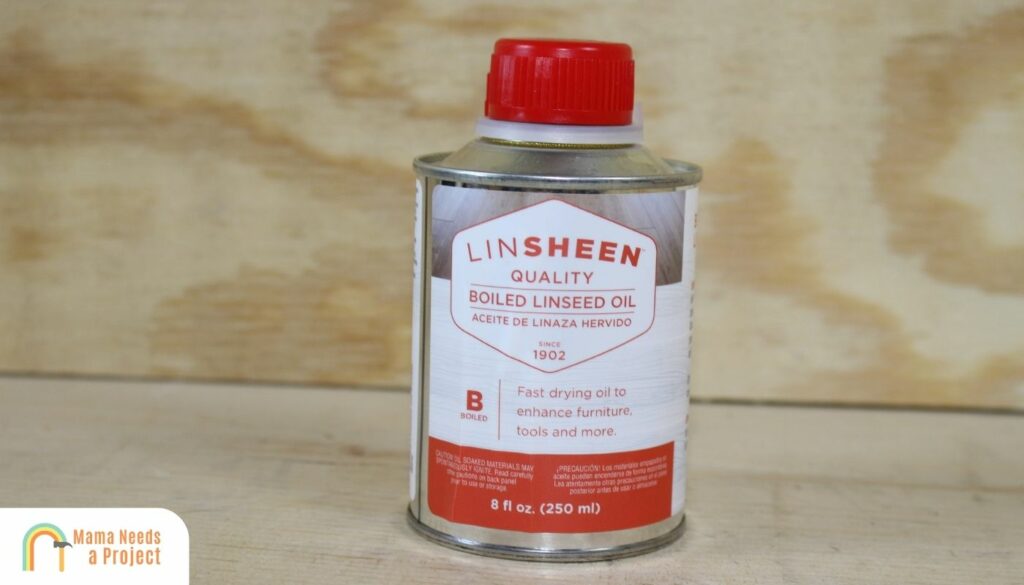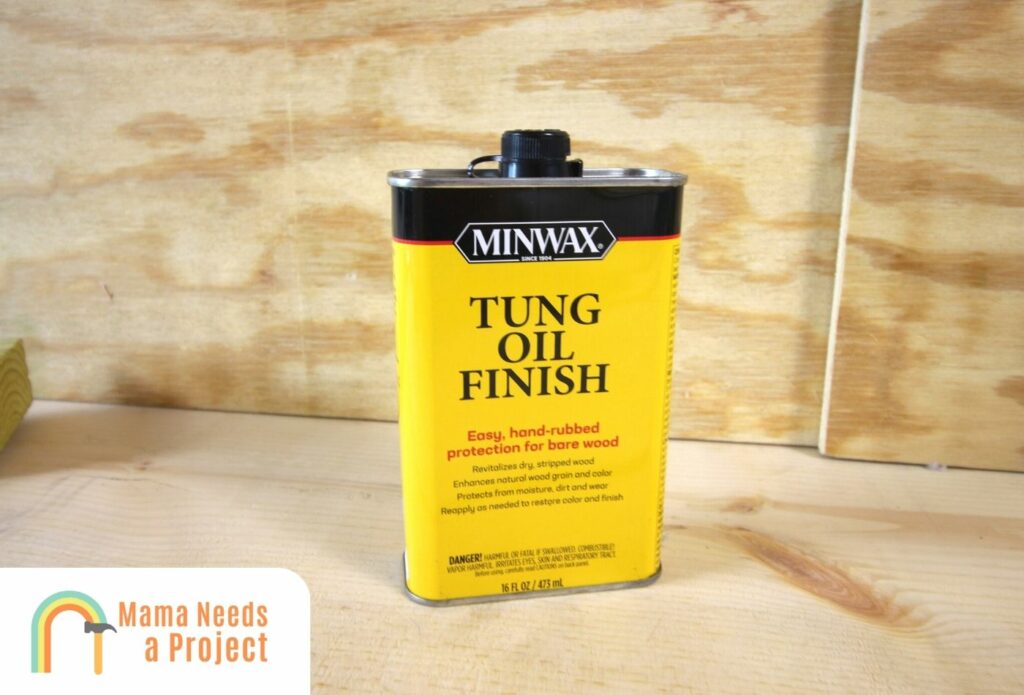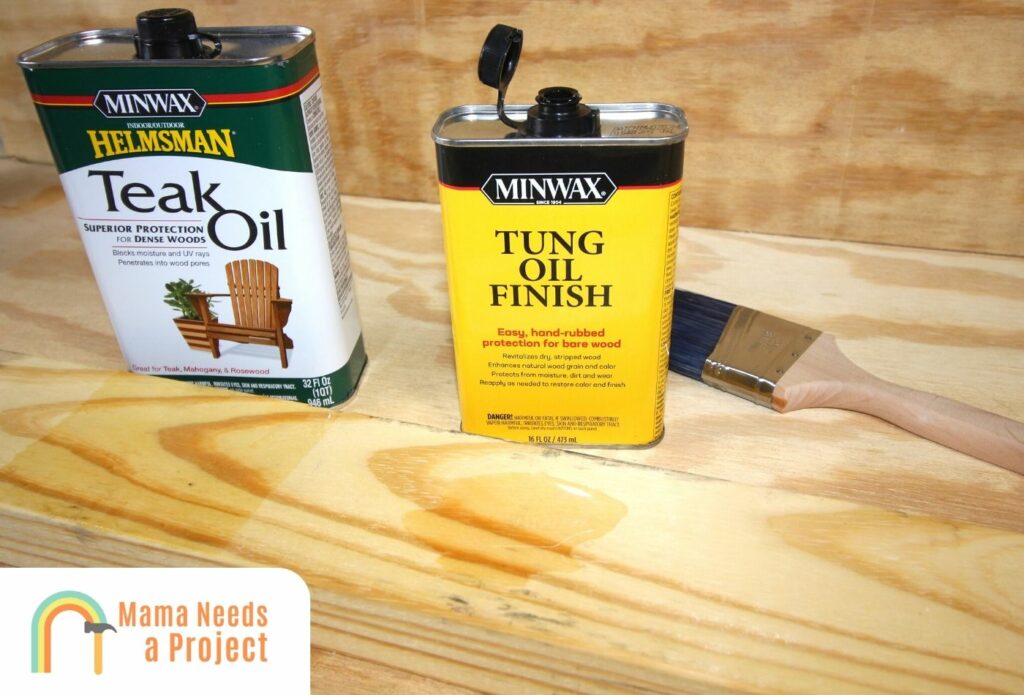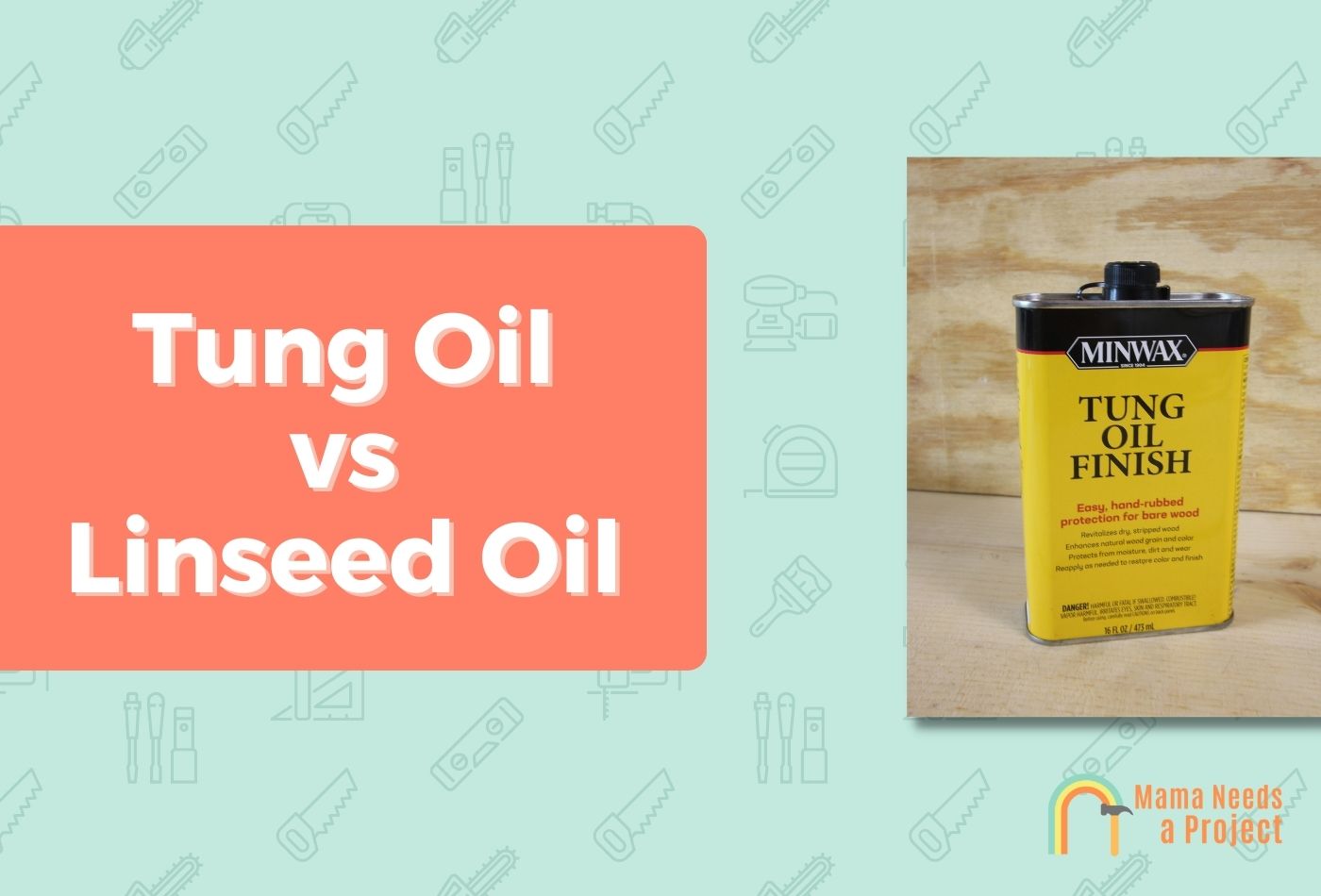Tung Oil vs Linseed Oil: Which is Better (Ultimate Comparison)
Are you trying to decide which finishing oil to use on your wood project? Two of the top choices are tung oil and linseed oil, but which one is best for your specific needs?
In this post, I’ll take a deep dive look into tung oil vs linseed oil, to help you determine which is best for your project. Let’s dig in!
- Both tung oil and linseed oil are great finishes for just about any wood surface.
- The key differences when comparing tung oil vs linseed oil include the durability, drying time, and ease of application.
- If you want more durability or water resistance – go with tung oil.
Tung Oil vs. Linseed Oil
Pros of Linseed Oil

- Raw linseed oil is food safe and a popular choice for butcher block countertops and cutting boards and it’s also a biodegradable oil making it better for the environment.
- Linseed oil is easy to apply and it is water-resistant.
- It amplifies the appearance of the wood grain and allows the wood to shine.
- Linseed oil can camouflage scratches and dents in wood, making it an excellent choice for wood flooring.
- Linseed oil has a long shelf life if stored properly and it’s pretty inexpensive and easy to find.
Cons of Linseed Oil
- Boiled linseed oil is NOT food safe and should not be used on surfaces like countertops or cutting boards.
- Linseed oil takes a long time to dry compared to tung oil.
- It is not a good choice for outdoor wood since it is not completely waterproof. It is especially unfavorable for high-humidity areas since it can create the perfect environment for mold and mildew.
- It is not permanent. You will need to reapply linseed oil every two years or so to keep a good seal of the wood grain.
- Linseed oil can turn yellow over time and isn’t water-ring resistant.
- It is NOT UV resistant, so it might not be the best stain for outdoor furniture.
Pros of Tung Oil

- Tung oil is easy to apply and an excellent choice for beginner woodworkers.
- It is non-toxic and can be used for kitchen items and even children’s projects.
- Tung oil finish will last for years and it can be used to waterproof wood.
- Tung oil does not yellow over time as linseed oil does.
- It is UV resistant.
- The tung oil finish gives a rich, honey color to the finished piece.
Cons of Tung Oil
- Tung oil is much more expensive than other wood oils.
- It has a strong odor and should be applied in a well-ventilated area.
- You must use a minimum of five coats to protect the wood with tung oil.
- Tung oil has a long processing time, and it can take up to 30 days to completely cure.
Key Difference Between Linseed Oil and Tung Oil
Tung Oil

There are two types of tung oil-pure tung oil and dark tung oil. Pure tung oil is just that: pure. It doesn’t have any additives and leaves you with a natural honey color.
Dark tung oil has additives such as varnish or stain in the mix, which gives the oil a darker, more rich color when dry.
Origin of Tung Oil
Tung oil is created by drying and pressing nuts from the tung tree, a tree native to China. The Chinese people have been using tung oil for centuries, and it is said that they used it to protect ships from the elements and the sea all the way back in the 14th century.
Mass production of oil in the USA didn’t start until the 1930s, and it is still an extremely popular wood almost a century later. Since it is from a tree, it has gained even more popularity for its environmentally friendly characteristics.
Tung Oil Uses
Tung oils can be used for all kinds of woodworking projects. Here is a brief yet eye-opening list of the different applications of tung oil.
- Outdoor furniture
- Patio flooring
- Birdhouses
- Siding
- Indoor furniture
- Cabinetry
- Wooden instruments (like a guitar)
- Countertops
- Cutting boards
- Children’s toys
Drying Time
The drying time will depend on the airflow and temperature of the space you are working in. However, it’s best to allow tung oil to dry between coats for at least 24 hours. Sometimes it will take long and can take up to 4 days.
Since you need to apply at least five coats of tung oil to a project for the proper finish, this is probably the biggest downside to using tung oil. But on the flip side, you won’t need to reapply coats for many years if your first application is done correctly.
After you have finished applying the required amount of coats, you will need to let the piece sit and allow the tung oil to cure. This can take anywhere between 5-30 days, depending on the environment.
You will know when the oil has cured when the surface is completely dry and hard.
Tung Oil Alternatives
Some of the best tung oil alternatives include:
- Teak oil
- Danish oil
- Mineral oil
- Polyurethane
Are you looking for a stain for your outdoor furniture? Check out these best stains for outdoor furniture!
Linseed Oil
There are three main types of linseed oil- pure linseed oil (also called raw), Polymerized linseed oil, and boiled linseed oil. Here are the main differences between the different linseed oil varieties.
- Pure Linseed Oil: As the name suggests, this is the purest form of linseed oil. There are no additives, and it hasn’t been treated in any special way. This type takes the longest to cure.
- Polymerized Linseed Oil: This type is created by taking pure linseed oil and heating it up to over 550 degrees Fahrenheit for multiple days. This adds viscosity to the oil and shortens the cure time.
- Boiled Linseed Oil: The name is a bit deceiving since the oil is not boiled to create boiled linseed oil. In fact, boiled linseed oil is raw linseed oil that has drying agents added to it to shorten the drying and curing time of the oil in its pure form. The additives added to the oil are toxic, so if you choose to use this type, ensure you are applying it in a well-ventilated area. I would also recommend to NOT use boiled linseed oil for any kind of food-related items or children’s toys. It’s best to veer on the side of caution when it comes to chemicals and toxins.
Origin of Linseed Oil
Linseed oil is one of my many byproducts of the flax plant and has been used for a wide variety of uses throughout the years. It has been used for thousands of years, though it is hard to say when it became a popular choice for wood finishes.
Throughout the centuries, linseed oil has been used in cooking, painting, medicines, woodworking, cleaners, leather conditioners, and nutritional supplements, to name a few.
Linseed Oil Uses
When it comes to woodworking, there are many different ways you can use linseed oil in your projects. Here is a list of projects where you can use linseed oil to protect wood.
- Wood flooring
- Wood furniture
- Countertops
- Cutting boards
- Cabinetry
- Boxes and crates
- Children’s toys
- Tool handles
Drying Time
The drying process of linseed oil is extensive, to say the least. Before you choose to use this oil, you should be well aware that it will take many days to complete a project.
You must wait 2-3 days between coats to allow the oil to dry completely before you apply the next coat. You also need to sand between coats to ensure you get an even, clear coating.
Though it does take a long time to go through the applying and drying process, the finished product is well worth the wait.
You will also need to reapply at least two coats every two years or so. Before reapplying your first coat, ensure you sand the previous linseed oil barrier to make sure you get a beautiful clear finish.
Linseed Oil Alternatives
Some of the best linseed oil alternatives include:
- Shellac
- Varnish
- Lacquer
- Teak Oil
Here’s a great video explaining the different outdoor wood finishes!
FAQs
What’s the Best Oil to Use on Wood?
There is a great debate on tung oil vs. linseed oil, and to tell the truth, the best oil is going to depend on your personal preferences and project. Both linseed oil and tung oil work well with most woods, and they both have their own set of pros and cons.
There’s no denying the longevity of both oils since they’ve been around for hundreds and even thousands of years, so as long you choose one of them, you should be good to go.
Keep in mind tung oil is better suited for outdoor projects, and linseed oil has a very long processing time.
What is the Best Oil to Waterproof Wood?
Tung oil is your best option for an oil that can create a waterproof seal for wood. It has been used for thousands of years for that exact application for ships and boats.
When you apply the tung oil to the wood, ensure you thoroughly cover the wood and don’t miss any spots. If you miss a spot, the wood won’t be waterproofed, and water will seep into that “weak” point.
What is the Best Oil to Protect Outdoor Wood?
Pure tung oil is an excellent choice for protecting outdoor wood. Another industry standard oil that we didn’t discuss in this post is teak oil. Both options are great choices for protecting your outdoor furniture and deck from harsh elements.
Final Thoughts
Both tung oil and linseed oil can be great options to protect wood surfaces. Both are natural oils that do a fantastic job of showing off your woods grain while adding protection.
Ultimately, if you’re working on an outdoor wooden surface, I’d recommend going with tung oil because of the added water resistance.
If you’re going to finish wood furniture for indoor use, linseed oil can be a great choice.

Miriam Ronne wears many hats, including but not limited to freelance writer, blogger, professional quilter, serial DIYer, and obsessed dog mom. She loves to teach beginners how to do all sorts of crafts and techniques. If she’s not writing her next blog post, she’s either sewing a new project or playing with her pup. You can find Miriam on her blog, Stitch Obsessed, or connect with her on Instagram.

